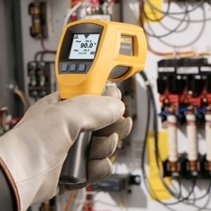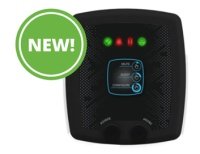3 Common Misconceptions About Digital Infrared Thermometers

Many misbeliefs surround infrared thermometer use, and all too often, these lead to frustration and inaccurate temperature measurements.
This article lists the three most common misbeliefs and then dispels them to help you make accurate, informed infrared thermometer measurements.
1. ❌ An infrared thermometer measures anything
✔️ An infrared thermometer measures the surface temperature of objects
An infrared thermometer measures the surface temperature of measured objects only. A good example is cooking – an infrared thermometer is excellent for measuring the pan temperature or the surface temperature of foods – but it will tell you nothing about the internal temperature. So to check your steak is adequately cooked on the inside, you will need a probe thermometer.
2. ❌ The laser on an infrared thermometer measures temperature
✔️ The laser pointer is a guide for taking measurements only
Your infrared thermometer could feature either; no laser pointer, a single laser, a dual laser or several points. The laser serves as a guide to the measurement area and has nothing to do with temperature measurement itself.
For the most part, single-point devices will guide you to either the centre, above or below a measurement area. Dual-point laser pointers typically highlight the outer edge of the zone you wish to assess. Please check your user manual for device specifics.
See Figure 1 (below) for examples of laser pointer locations compared to the measuring area.
Figure 1 Measurement area and examples of laser pointer locations
3. ❌ An infrared thermometer can measure all surfaces
✔️ Different surfaces could require emissivity value adjustments
Emissivity measures how efficiently a surface emits energy as infrared radiation as measured on a scale of 0 to 1.
High emissivity objects absorb reflected or ambient infrared energy and emit (primarily) their infrared radiation. Infrared thermometers take more straightforward and accurate readings of high emissivity surfaces.
On the other hand, objects with low emissivity, like shiny, reflective and polished metals, reflect ambient infrared energy and are less effective at emitting their electromagnetic waves.
The emissivity of many everyday objects falls within a range of 0.95, so you will often see this as the default setting for most infrared thermometers. You will need an infrared thermometer with adjustable emissivity to measure low emissivity surfaces.
See Table 1 (below) for examples of emissivity values of common surfaces.
|
Material |
Emissivity |
|
Polished Aluminium |
0.05 |
|
Copper |
0.4 to 0.8 |
|
Black electrical tape |
0.95 |
|
White paper |
0.90 |
|
Black paper |
0.95 |
|
Clear plastic |
0.94 |
|
Concrete |
0.95 |
|
Typical foods |
0.8 to 0.95 |
|
Timber |
0.9 to 0.95 |
|
Soil |
0.9 to 0.98 |
|
Skin |
0.98 |
Table 1 Common materials and their corresponding emissivity values
Conclusion
Understanding how an infrared thermometer takes measurements is crucial to perform accurate and reliable measurements. To recap:
- Infrared thermometers measure the surface temperature of objects and do not measure internal temperatures.
- Lasers on infrared thermometers do not read the temperature. They are guides only.
- Check that your IR thermometer is ideal for the surfaces you wish to measure. Most infrared thermometers have a default emissivity value of 0.95, which is suitable for most everyday objects. However, low emissivity, i.e. bright, shiny, reflective objects, will require a thermometer with adjustable emissivity.
If you need a hand taking a measurement or e, speak with an Instrument Choice Scientist – we’re here to help! Call 1300 737 871 or email [email protected].
Browse all digital infrared thermometers here
Also interesting
We’re excited - Lascar Electronics has been busy developing a new and impressive wireless IoT data logger! And when Lascar creates new products, especially in the cutting-edge field of IoT, it’s time to pay attention.
So, if you currently exploit the power of the IoT, are considering updating or expanding your equipment, or have a passion for new devices, check out the Instrument Choice Scientists’ introduction to the NEW EL-IOT-1 Cloud-Connected Temperature Data Logger by Lascar!

Cleanroom facilities are prone to environmental contamination, making particle counters invaluable tools for managing lab spaces that must be kept in a pristine state. This article provides the essentials for quickly determining the best particle counter solution for your cleanroom application.
Get the hints and tips for finding the right particle counter for your cleanroom

